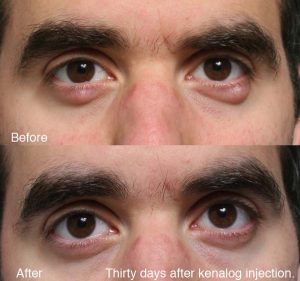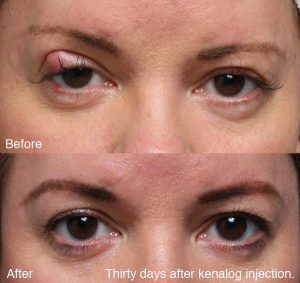A chalazia is an inflammatory bump that can develop along the edge of one of the eyelids. If you have one, I don’t need to tell you they are ugly. There is a related process called a stye or hordeolum. You might ask what if there is a difference? The stye develops suddenly and is more often related to a bacterial infection. Styes, also known as a hordeolum, are painful. When they point on the skin side, they are called an external hordeolum and when they point inside the eyelid, they are called an internal hordeolum. Generally the initial management for the stye is warm compresses and antibiotics due to the higher likelihood of a bacterial infection. They can form an abscess and drain. In contrast, chalazia may develop quietly with little or no pain. Their development is associated with a clogged meibomian gland-an oil gland in the eyelid. When these clog, oil can leak out of the gland causing irritation and inflammation in the surrounding eyelid resulting in the bump seen in the eyelid.

Chalazia are painless nodules that can develop along the eyelid margin. If you have one, you know they are ugly and you may have been told that your only option is surgical removal. Don’t agree to surgery. There is a better alternative.
The stye can quiet down and resolve or evolve into a chalazia. Chalazia can persist and don’t always resolve on their own using conservative measures such as a warm compresses and eyelid scrubs. These are measures that sound good, won’t cause harm, but seldom provide relief of the chalazia.
Generally your family doctor does not want to take care of these lesions and prefers to send you to the ophthalmologist for care. An ophthalmologist is an eye M.D. who has completed 4 years of medical school, one year of internship, followed by 3 to 4 years of residency training in eye surgery. Don’t confuse them with optometrists who do not attend medical school and have much less training. This is an issue because in some states, the optometrist may not refer you to the eye M.D. and instead will treat these lesions themselves and the results are not always ideal. I have a bone to pick with ophthalmologists as well how they manage chalazia. They almost always want to incise and drain the chalazia. That is a cutting surgery done after injecting the eyelid with local anesthetic. You may not feel you have a choice, but you do.
It turns out that many, many chalazia respond beautifully to a kenalog injection without the need for surgery. It is still several pokes with a tiny needle so honestly it is still uncomfortable but this is improved with numbing cream and a small bit of local anesthetic. Not all eyelids respond to the kenalog. About 30% need a second injection a month later. In rare cases, surgery is still needed despite significant improvement in the overall size of the chalazia. As you can see with the before and after photos of two recent cases, the improvement can be profound and result in an outcome that is as good or better than surgery. Call the office to schedule your consultation with Dr. Steinsapir.
About Dr. Steinsapir
Dr. Steinsapir is a board certified eye surgeon and fellowship-trained in oculoplastic surgery and cosmetic surgery in Beverly Hills. He specializes in balanced facial cosmetic surgery for natural results, with an emphasis on minimally invasive techniques, fast recovery time, and leadership in medical technology. He fixes prior unsatisfactory cosmetic eyelid surgery using advance methods, many of which were developed by Dr. Steinsapir. He sees patients at his state of the art private practice in Beverly Hills and also serves as an Associate Clinical Professor of Ophthalmology at the Jules Stein Eye Institute, at the David Geffen School of Medicine at UCLA. Contact us today to learn how Dr. Steinsapir’s experience and training can make the difference for you.

